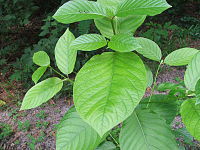
Photo from wikipedia
Abstract Context Depression is a mental disorder characterized by low mood, reduced interest, impaired cognitive function, and vegetative symptoms such as sleep disturbances or poor appetite. Iridoids are the active… Click to show full abstract
Abstract Context Depression is a mental disorder characterized by low mood, reduced interest, impaired cognitive function, and vegetative symptoms such as sleep disturbances or poor appetite. Iridoids are the active constituents in several Chinese classical antidepressant formulae such as Yueju Pill, Zhi-Zi-Hou-Po Decoction, Zhi-Zi-Chi Decoction, and Baihe Dihuang Decoction. Parallel to their wide usages, iridoids are considered potential lead compounds for the treatment of neurological diseases. Objective The review summarizes the therapeutic potential and molecular mechanisms of iridoids in the prevention or treatment of depression and contributes to identifying research gaps in iridoids as potential antidepressant medication. Methods The following key phrases were sought in PubMed, Google Scholar, Web of Science, and China National Knowledge Internet (CNKI) without time limitation to search all relevant articles with in vivo or in vitro experimental studies as comprehensively as possible: (‘iridoid’ or ‘seciridoid’ or ‘depression’). This review extracted the experimental data on the therapeutic potential and molecular mechanism of plant-derived iridoids for depression. Results Plant iridoids (i.e., catalpol, geniposide, loganin), and secoiridoids (i.e., morroniside, gentiopicroside, oleuropein, swertiamarin), all showed significant improvement effects on depression. Discussion and conclusions Iridoids exert antidepressant effects by elevating monoamine neurotransmitters, reducing pro-inflammatory factors, inhibiting hypothalamic-pituitary-adrenal (HPA) axis hyperactivity, increasing brain-derived neurotrophic factor (BDNF) and its receptors, and elevating intestinal microbial abundance. Further detailed studies on the pharmacokinetics, bioavailability, and key molecular targets of iridoids are also required in future research, ultimately to provide improvements to current antidepressant medications.
Journal Title: Pharmaceutical Biology
Year Published: 2022
Link to full text (if available)
Share on Social Media: Sign Up to like & get
recommendations!